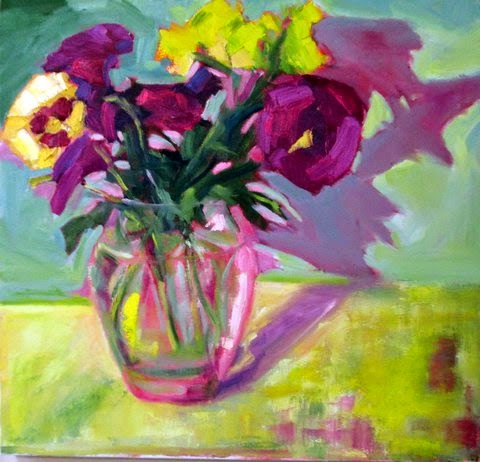Alfred Chadbourn Inspires at the Ogunquit Museum
In painting, as in life, you can get away with a great deal as long as you have your values right. (Harley Brown)
 |
| Alfred Chadbourn "Beach Scene" |
 |
This was the first large show of Chadbourn's work that I have seen, and there were oil paintings only, mostly painted in Maine. I would have loved to have seem some drawings, perhaps a sketchbook, and work in other media. Did he work with water media or pastel? It seems likely.
Wanting more about his work, some research turned up this excerpt from an article in a 1987 Artist Magazine written by Charles Sovek:
 |
| "VW Five Islands" |
Behind the deceptively simple paintings of Al Chadbourn is a sophisticated designer. Few artists are better able to manipulate just a few values and colors into totally satisfying arrangements. The trick, as it seems, is really no trick at all. His beautifully designed, "simplified" works result from the skillful use of only three values. And this lays the foundation for his thick-and-thin painting techniques that add vitality and life to his works.
Chadbourn's paintings usually start with exploratory sketches, using either a felt-tip pen or a charcoal pencil. Working directly on location, his main interest is simple value arrangements. "I try to reduce everything to three values - a light, middle and dark tone. That way, the chances of retaining my initial impression are much better," says Chadbourn. He also takes reference photos, but prefers to work from sketches when painting back in the studio: "They bring back the feel of the wind blowing and the squawking of the gulls."
Technically, Chadbourn's painting methods are conventional. He works on canvas (medium or rough linen) and occasionally Masonite primed with acrylic gesso for small works. He uses flat bristle brushes (Nos. 10, 7, 5 and 3), bright bristles in the same sizes, and a small, inexpensive sable for details. He also finds a palette knife useful for both scraping off unwanted paint, as well as applying color when thickly textured effects are desired.
Like many painters, Chadbourn uses a simple palette comprised of alizarin crimson, thalo red, cadmium red light, cadmium orange, cadmium yellow light, yellow ochre, burnt sienna, permanent green light, thalo green, ultramarine and cerulean blue. I use cerulean instead of thalo blue because thalo is such a dominant color; I found myself getting it into everything," he says. His taboret is an old baby bassinet with a windshield glass for a top.
The way Chadbourn usually works is to wash in large passages of a picture with paint thinned with lots of turpentine. Once the design and mood are established, he carefully overpaints, letting the underpainting show through where it serves the purpose best. As the work progresses, thicker applications of paint are added, thinned with turpentine and little or no medium.The paint application did not seem so much "thick and thin" to me, more "thin and thinner" often using dripping very thin washes to create textural layering. The dominance of color temperature over veracity of hue is effective in Chadbourns' art and it felt familiar. I felt that influence reverberate in the work of a number of Maine artists painting today.
His figurative work is so great, so fun and so alive. I want to see more of that, too.
The show "Alfred Chadbourn: Painting in Maine" is up at the Ogunquit Museum of American Art until August 30. ogunquitmuseum.org
Alfred Cheney Chadbourn(American, –1998)
 |
| Alfred Chadbourn "Self Portrait in the Studio" |
After leaving France, Chadbourn spent three years teaching art at Queen’s College (New York City) and hanging around the famous Cedar's Bar in Greenwich Village – meeting place then for emerging abstract expressionists such as Willem de Kooning, Robert Motherwell, Jackson Pollock, Franz Kline and others. "For a while I tried working non-representationally," he says, "but discovered it wasn't my way." The influence, however, was an important contribution to his ability to see realistic subjects in abstract terms, which gives his paintings their singular quality and force.
Chadbourn was elected a full member to the National Academy of Design in 1971, and his paintings are now in numerous corporate and private collections around the world.

Janet thank you. This is an inspiring post. I have only seen one of Chadbourne's paintings "live". I recall the delightfully bold and painterly over painted areas - I wonder if he painted out staccato shapes in favor of design economy. Maybe I'm giving myself a challenge in saying that. I'm curious about your observation ... Am I getting it straight that he nailed down values and color temperature while taking liberties with hue? If so would you say he was marking a color statement along the lines of abstraction or simply working with the relativities of paint to depict life?
ReplyDeleteJanet thank you. This is an inspiring post. I have only seen one of Chadbourne's paintings "live". I recall the delightfully bold and painterly over painted areas - I wonder if he painted out staccato shapes in favor of design economy. Maybe I'm giving myself a chalkenge in saying that. I'm curious about your observation ... Am I getting it straight that he nailed down values and color temperature while taking liberties with hue? If so would you say he was marking a color statement along the lines of abstraction or simply working with the relativities of paint to depict life?
ReplyDelete